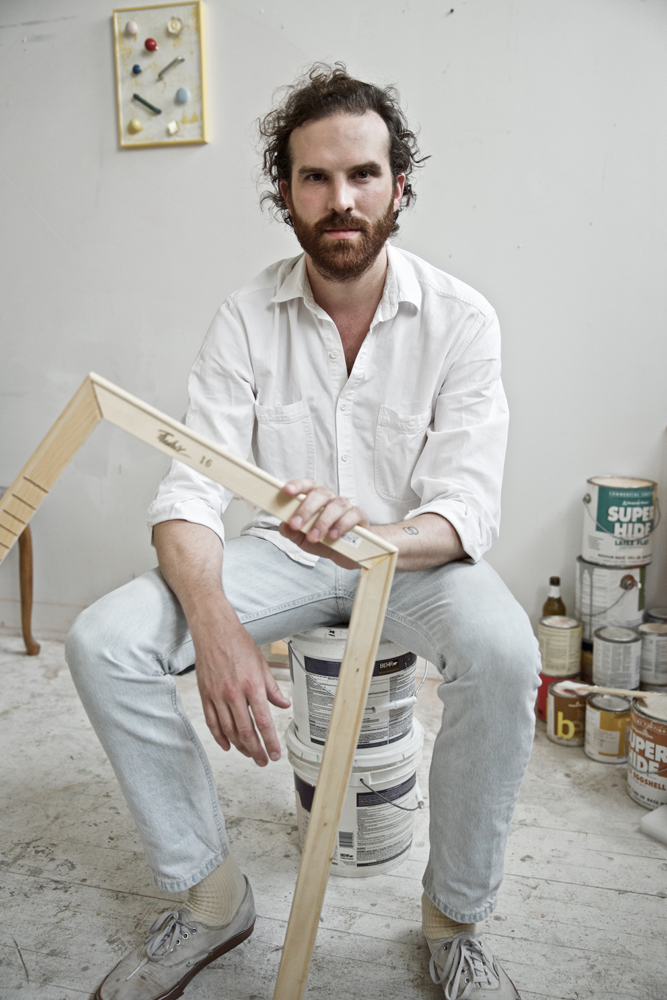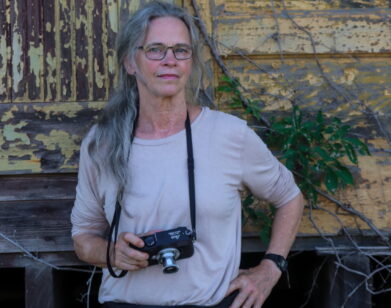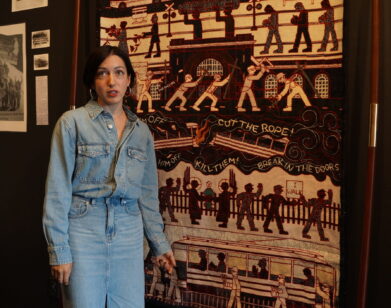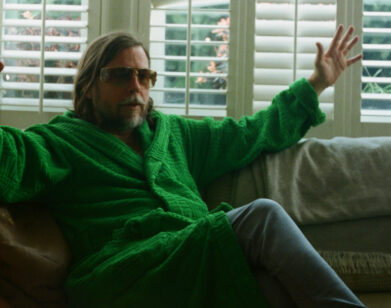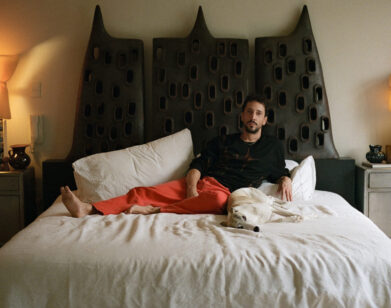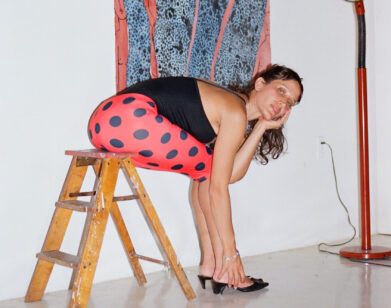Artists at Work: Jeffrey Tranchell
JEFFREY TRANCHELL IN BROOKLYN, NEW YORK, AUGUST 2015. PORTRAIT BY FRANK SUN.
This month we’re visiting New York-based artists in their studios, ahead of their fall solo exhibition openings.
Ascribing maxims to something as perpetually in flux as an art practice is a tricky business, but for the work of Jeffrey Tranchell, “waste not, want not” has become a critical directive. The 32-year-old Michigan native and founding member of Lower East Side gallery Essex Flowers preoccupies himself with economics of purpose—value, waste, and application—in how he sources the materials used in his colorful, cheeky art objects. Wood is found in scrap piles; paint is purchased from the hardware store’s custom color reject pile; and leftover detritus is not merely a byproduct, but readily available to be reused and recycled in a yet-to-be-created work. Loaded with previous histories, these materials find new lives repurposed and misused in ways contrary to their original utility, intelligently crafted by Tranchell into new aesthetic forms.
Tranchell’s self-prescribed resourcefulness decrees a set of limitations he must work within, boundaries he’s happy to explore to before abandoning them for the next thing. But as of late, the results have divided themselves into three categories: Canvases pulled over distorted stretcher bars form oblique shapes, mounted to walls as paintings; angular table-top sculptures composed of jagged, screwed together painted wood fragments extend into space; a series of medium-scale, rectangular framed 3-D paintings, layered with textured backgrounds of paint or pegboard and applied with striking, multicolored or metallic geometric cabinet knobs and pulls, play with gravity and spatial understanding in the picture plane.
Next month, several of these works will be exhibited in a group exhibition at Sorry We’re Closed in Brussels, along with contributions from Graham Collins and Noam Rappaport. A certain sly humor runs through Tranchell’s body of work (his website presents select paintings and sculptures as dancing .gifs, wittily demonstrating their dimensional views), but as he says, he avoids pursuit of cynicism or kitsch. Ahead of the show, we spoke with Tranchell over beers at his meticulously organized studio, situated on an industrial stretch of the Williamsburg-Greenpoint border in Brooklyn.
COLLEEN KELSEY: Something I enjoyed about one of your artist statements was that you incorporated this zinger about how Catholic guilt tied into your preoccupation with waste and value. I know those ideas are important to the materials you use to make an artwork, but how do you first decide what material is worthy of use?
JEFFREY TRANCHELL: I don’t think I’m sure of that yet upon discovery of materials. There’s plenty I’ve hauled from one studio to another and never made use of, and then there’s other things I didn’t intentionally acquire, that surprise me. I’ll even make use of something and it could be months before I decide it’s a terrible artwork. It’s funny, I almost feel like I’m as satisfied with a failure that I can finally write off, as much as I am a success, because at least that’s a resolution. I can finally part ways with this material, which I feel is really irrational, but I can’t throw away a fresh sheet of plywood. If I cut it into pieces for one reason or another and produce nothing of interest to myself, at least then I can finally comfortably call it a day with the material.
KELSEY: Do they ever resuscitate themselves later on?
TRANCHELL: There’s definitely things that lie around and still find their way into an artwork. There’s a lot of artworks that I feel successful with at one moment, and later on I’m no longer happy with, and will become cannibalized into another piece. It’s almost one of the reasons I like parting ways with an artwork when I can, because I just know anything in [the studio] is still vulnerable to becoming cannibalized into the next work of art.
KELSEY: When did you start making these knob and pull paintings?
TRANCHELL: I’ve been making these about four or five years now. I usually find myself feeling like I need to move off of something after that long, but they’ve still kept my interest and they’ve still been changing. They’re a good means of using up resources, too, just because of their scale and how many options lay within these home decorating techniques.
KELSEY: Where do you go for the home décor objects? Is it like a Home Depot situation?
TRANCHELL: Most of these [objects] are from Oriental, which is a lumberyard over here. Then there’s another hardware store in the city called Convenience, which I just discovered is closing—it’s run by a nice Russian family. I definitely have, I don’t want to say defiance, sort of like a guilty conscience shopping at big box stores. You’re not going to find most of these at a Home Depot. A lot of them have a real Chinatown vibe, actually, but there’s a certain level of kitsch, which I think Home Depot wants to disassociate themselves with.
KELSEY: Are you actively sourcing for kitsch elements?
TRANCHELL: You know, I’m surprised to hear the word come out of my mouth, because I don’t really associate with kitsch. I’m certainly amused with the kind of decorative aspirational qualities of the materials, but I just feel the word “kitsch” has a very cynical slant to it, which isn’t something I care to embrace. That’s why I avoid the “K” word. But they are consumer products that are made to please the masses, but at the same time it’s funny, because I feel like with these, they missed. That’s why The Home Depot doesn’t carry these; even as consumer goods they’re a bit of a failure. I’ve never made the connection, but most paint I buy is “oops” paint, stuff the hardware store screwed up. They either did the wrong machine, or it wasn’t the color someone wanted, or the person just didn’t come pick it up. I deal with materials from sources that certainly are functional, their purpose is utility to some degree, but usually by the end of their involvement within an artwork, that utility can cancel out. It’s prioritized in an aesthetic or a visual design that cancels out its utility, or at least its utility as a functional object, and not an art object.
KELSEY: This is somewhat unrelated, but I know you’ve renovated, or are in the process of renovating, a house in Detroit. Do personal construction projects affect how you think about an artwork?
TRANCHELL: If nothing else, it’s more trips to the hardware store. I always joke that a lot of the artworks are excuses to use the stuff I find that I don’t have a reason for. I’m not covering anything in my home in faux stone. It’s usually the complete opposite side of the spectrum, what I’m doing to an artwork. At home I’m stripping down the linoleum and the vinyl floor and sanding it back down to raw wood and painting the whole place white; its intentions and aesthetics are almost opposite priorities. It’s definitely always on my mind, that experience definitely offers plenty of new discoveries, and if nothing else, I have a nightmare of a garage full of leftover materials that are going to need to find some sort of a home.
KELSEY: When do you know when to stop working on a successful work?
TRANCHELL: It sneaks up on you. I remember Christopher Wool talking at a lecture. Him and his wife would have a joke, they would leave the studio and joke to the other one: “I was a genius today.” It’s always that work that you come back to the next day and cringe at. It’s the things that you think are completely unfinished that surprise you in the end. It’s hard. I don’t think it’s as complicated as I make it, but it’s still difficult, because even when I figure something out that I can count on, I start playing head games with myself. Something we all hear a lot as artists, is that we’re supposed to constantly be pushing forward and reinventing what it is we’re doing, but at the same time, I don’t know. When you got a good thing going you should also learn to take advantage of that.
KELSEY: Have you always worked with scrap, industrial, or prefab materials?
TRANCHELL: No. Early on in my time in New York that started to happen, but before that I tried to stay as reductive as possible. Most of the works I did were just pen on paper, drawings. It’s just a different kind of limitation, whether it’s dealing with what I’m finding around me, or what’s the byproduct of a previous work, one self imposed inscription or another.
KELSEY: How do you usually set those limits?
TRANCHELL: It’s not extremely dogmatic. Years ago I used to be a little more dogmatic in the way I’d make things. I would very specifically restrict myself to just pen, just paper, just marker, just one color paint. I’m not so much that way anymore. In fact, I always enjoyed the contradiction where it is: you have what seems a certain ideology about how you make work, but then at some point you betray it in favor of some other thing. I still enjoy that working method of setting restrictions, but at the same time I don’t want to be a slave to that idea.
KELSEY: Is there a prevailing ideology for you right now?
TRANCHELL: At most, maybe like life mottos: “Waste not, want not.”
KELSEY: Does that reflect in the titles of the works as well?
TRANCHELL: Yeah, I make long lists of titles that are just phrases not identified with any specific artwork. I almost never use any of them, so I’ve got about 200 titles ready to go. I never end up making those works, or it just seems too anonymous. I’ll end up defaulting to brand names, or stickers. I usually very literally will find something that’s like a Formica sample hanging off of that [gestures] one sculpture. Whatever the color is, is the title of that piece, like “Cherry,” whatever the factory has decided. It’s almost always inherited.
KELSEY: Do you find when you’re starting a work, that the material leads it the most at the beginning?
TRANCHELL: I strive for that as much as possible. There are times when I feel like that’s my interest, and there are times when I feel like I’m just trying to stay out of the way of something as best I can. Even as far as just not wanting to have too high a level of craftsmanship, or finish [on the material.] It’s like if you drive a screw into a piece of wood and you patch it, you don’t want to sand it perfectly. You want to leave a little history. You want people to know what they’re looking at. Flaws and all, I definitely try to be honest about what the material is.
KELSEY: Do you get different levels of gratification with that in making a sculpture versus making a painting, or is it variable?
TRANCHELL: It all depends on how resolved I feel with that individual piece. There is something slightly more sincere in the sculptures, in that they really depart lightly from their previous existence or their actual qualities, where a painting usually will inherently ask for a little bit more suspension in understanding what it actually is, whether it’s because it’s a two-dimensional plane, or it requires a little more management.
KELSEY: I also was curious about your thoughts on framing. [In the rectangular knob paintings] the plane is more contained, there’s a little bit more surface play and manipulation, but there are limits in terms of the size and the scope of the thing, whereas the irregular shaped paintings break those limits.
TRANCHELL: They both very much deal with, not two-dimensional objects, but three-dimensional objects. The shaped canvasses, I also feel like the framing helps give a few more clues. We could all could guess that underneath that canvas is some sort of wood stretcher substrate, but you know it’s not totally available, so I feel like the idea of soaking and bending the wood frame can give a few clues as to how exactly the substrate found that shape. I do like there to be an awareness of that substrate, because part of that restriction is trying to use pre-made material and push it outside of its intended use, practice, or test its limitations. You can see how it’s done.
TO VIEW MORE OF TRANCHELL’S WORK, VISIT HIS WEBSITE

